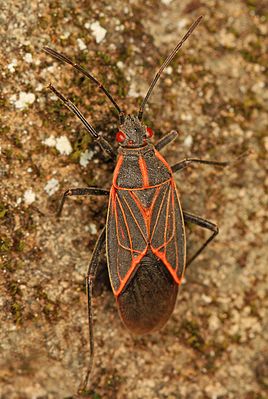Boisea rubrolineata
| Boisea rubrolineata | ||||||||||
|---|---|---|---|---|---|---|---|---|---|---|

Boisea rubrolineata |
||||||||||
| Systematics | ||||||||||
|
||||||||||
| Scientific name | ||||||||||
| Boisea rubrolineata | ||||||||||
| ( Barber , 1956) |
Boisea rubrolineata is a bug from the subfamily Serinethinae within the family of glass wing bugs (Rhopalidae).
features
The bugs are 10 to 14 millimeters long. The head, antennae and legs are black. The eyes are red. The lateral edges of the black pronotum and a central longitudinal stripe are colored orange. The abdomen, which is usually covered by the hemielytres , is orange. The black scutellum has a small orange spot on the apical tip. The black colored hemielytres have an orange outer border. An orange stripe runs along the lower edge, at the transition to the membrane, which is also black. The hemielytres are covered in lines with several orange veins .
distribution and habitat
The bugs are found in western North America. In Canada they are represented in British Columbia . In the United States, its range extends from the west coast to Idaho , Colorado and New Mexico .
Way of life
The bugs specialize in particular on the ash maple ( Acer negundo ) as a host plant. Other primary host plants are Acer grandifolium , the silver maple ( Acer saccharinum ), the bladder ash ( Koelreuteria paniculata ) and the soap nut tree ( Sapindus saponaria ). The bugs suck on the leaves, flowers and seeds of the trees. They are mainly found on pistillate (botanically female) seed-bearing ash-maple trees. The bugs also suckle on the fruits of almond, apple, peach, cherry, pear, and plum trees. They are also found on alfalfa , potato plants and rose plants , where they occasionally cause damage. For this reason, Boisea rubrolineata is considered to be a minor pest .
The bug species forms one generation in northern climes, and two or more generations per year in warmer areas. The bugs often go to human dwellings for the winter and are therefore considered annoying .
In English the bug is called Western Boxelder Bug - referring to the ash maple (English boxelder ) and the main area of distribution in the western USA.
Similar species
Boisea trivittata ( Eastern Boxelder Bug ) is a related and very similar species of bug. In contrast to Boisea rubrolineata, it occurs inthe eastern United States. Outwardly, the species differs by the dark colored veins of the hemielytras.
etymology
The name addition rubrolineata is derived from Latin : rubro for “red” and lineata for “striped”.
Web links
Individual evidence
- ↑ a b c d Western boxelder bug . Washington State University. Retrieved March 1, 2017.
- ↑ a b c d e f g h Species Boisea rubrolineata - Western Boxelder Bug . bugguide.net. Retrieved March 1, 2017.
- ↑ a b c d Boxelder Bug . University of California Agriculture & Natural Resources. Retrieved March 1, 2017.
- ↑ Danielle Gunn, Edward John Bechinski: Boxelder Bug - Nuiscance Management for Homeowners (PDF 206 kB) University of Idaho, Extension. Retrieved March 1, 2017.
Web links
- Boisea rubrolineata in the Integrated Taxonomic Information System (ITIS)